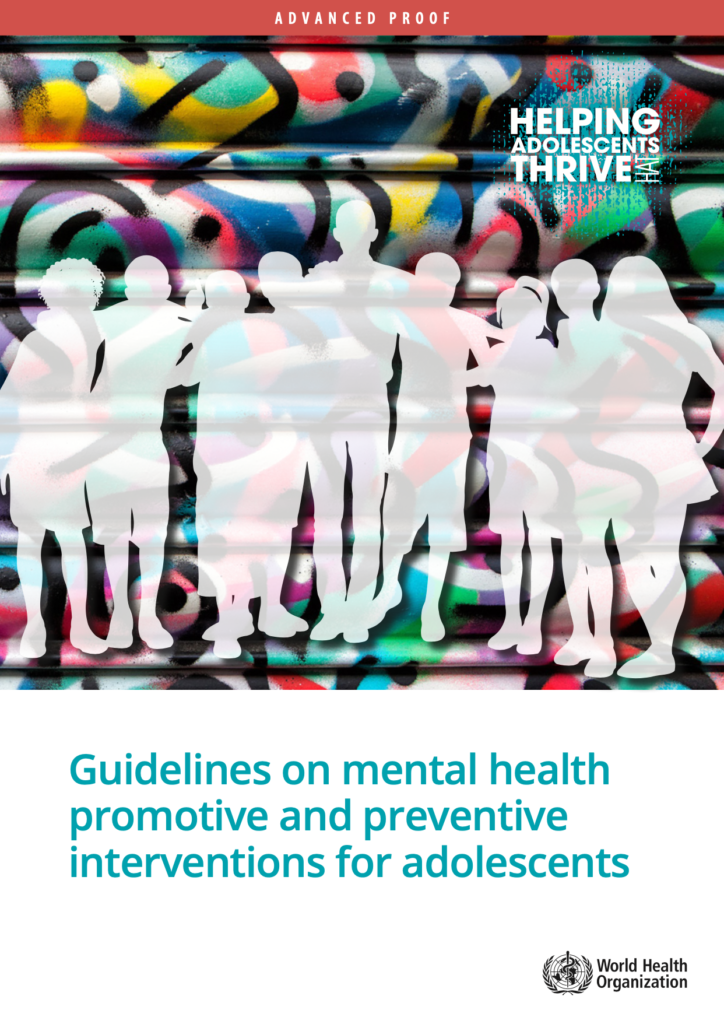The “Guidelines on promotive and preventive mental health interventions for adolescents – Helping Adolescents thrive (HAT)“, provide evidence-informed recommendations on psychosocial interventions to promote mental health, prevent mental disorders, and reduce self-harm and other risk behaviours among adolescents.
Mental health is a major issue for adolescents globally.
- Up to half of all mental health conditions start before the age of 14.
- Poor mental health is the leading cause of disability in young people, and accounts for a large proportion of the global disease burden during adolescence.
- Suicide is the third leading cause of death in 15 to 19 year-olds.
The long term impacts of mental health problems during adolescence include influencing risk-taking behavior, including self-harm; use of tobacco, alcohol and other drugs; risky sexual behaviors; and exposure to violence.
Overall young people are facing increasingly complex social, cultural and economic environments. Young people in minorities and young girls are disproportionately affected by mental health harms.
Guidelines for promotive and preventive mental health

The HAT Guidelines aims to inform policy development, service planning and the strengthening of health and education systems, and facilitate mainstreaming of adolescent mental health promotion and prevention strategies across sectors and delivery platforms.
To address these mental health harms, the new guidelines from WHO recommend a set of psychosocial interventions to promote mental health and prevent mental health conditions among adolescents, aged 10 to 19 years.
The recommendations are based on the results of intervention studies – both universal, delivered to all adolescents; and for selected individuals perceived to be at risk of mental health conditions. The guidelines aim to help inform the development of policies and programs for the improved mental health of young people.
The guidelines specifically focus on:
- Adolescents at increased risk of mental disorders or self-harm due to exposure to adversity;
- Adolescents going through challenging life circumstances such as adolescent pregnancy; and
- Those with early signs or symptoms of emotional or behavioral problems.
The interventions recommended can be delivered in school and community settings and through digital platforms.
WHO and UNICEF are in the process of developing a toolkit to facilitate the implementation of the new guidelines. The kit will include strategies for both supportive policies and laws and implementation of interventions in different settings.
Alcohol and mental ill-health
There are associations of alcohol use and alcohol use disorders (AUD) with almost every mental disorder, including depression, post-traumatic stress disorder (PTSD) and suicide.
In 2016, an estimated 283 million people aged 15+ years had an alcohol use disorder (AUD). That equals 5.1% of all adults worldwide.
The past 12-months prevalence of AUDs was the highest in the European Region and in the Region of the Americas.
- Europe: 66.2 million people aged 15+ years, representing 8.8% of the population of that age group
- Americas: 63.3 million, representing 8.2% of the population aged 15 years and older.
- Alcohol dependence (the most severe form of AUD) occurred in 2.6% of people of aged 15+ years in 2016.
- Americas: 4.1% prevalence of alcohol dependence,
- Europe: 3.7% prevalence of alcohol dependence.